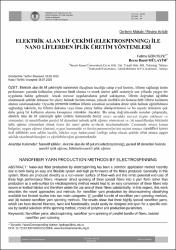| dc.contributor.author | Göktepe, Fatma | |
| dc.contributor.author | Mülayim, Beyza Buzol | |
| dc.date.accessioned | 2021-12-12T16:51:06Z | |
| dc.date.available | 2021-12-12T16:51:06Z | |
| dc.date.issued | 2015 | |
| dc.identifier.issn | 1300-7599 | |
| dc.identifier.issn | 2147-0510 | |
| dc.identifier.uri | https://app.trdizin.gov.tr/makale/TWpNMk16UXpNdz09 | |
| dc.identifier.uri | https://hdl.handle.net/20.500.11857/2481 | |
| dc.description.abstract | Elektrik alan ile lif çekimiyle nanometre ölçeğinde inceliğe sahip elyaf üretimi, liflerin sağladığı üstün performans yanında kullanılan yöntemin basit olması ve esnek üretim şekli nedeniyle son yıllarda yaygın bir uygulama haline gelmiştir. Ancak mevcut uygulamalarda genel yaklaşımın, liflerin doğrudan ağ-doku oluşturacak şekilde dokusuz bir yüzey halinde üretim olması, yüksek özellikli söz konusu özel liflerin kullanım alanını sınırlamaktadır. Oysa bu yöntemle üretilen liflerin kesintisiz uzunlukta direkt iplik halinde eğrilebilmesi sağlandığı takdirde, bu liflerin dokuma veya örme yüzey haline dönüştürülmesi ve bu sayede ürünlerin çok daha geniş bir kullanım alanına kavuşması mümkün olacaktır. Bu amaç doğrultusunda sunulan çalışmayla, elektrik alan ile lif çekimiyle iplik üretimi konusunda henüz sınırlı sayıdaki mevcut özgün yaklaşım ve yöntemler; (i) nanoliflerden paralel lif demetleri halinde iplik eğirme yöntemleri ve (ii) nanoliflerden bükümlü iplik eğirme yöntemleri olmak üzere iki temel gruba ayrılarak incelenmektedir. Çalışmada ortaya konan bulgular; uygun eğirme yöntemi, uygun hammadde ve üretim parametrelerinin seçimi sonucu nanolifleri içeren özel ipliklerin arzu edilen incelik, büküm veya fonksiyonel özelliğe sahip olacak şekilde nihai amaca uygun şekilde tasarlanabileceğini ve eğirilebileceğini göstermektedir. | en_US |
| dc.description.abstract | Nano-size fiber production by electrospinning has been a common application method recently due to both being an easy and flexible system and high performance of the fibers produced. Generally in this system, fibers are produced directly as a non-woven surface of fiber-web and this limits potential end-uses of these high performance fibers. However direct spinning of these special fibers into a yarn form rather than production as a web-surface by electrospinning method would lead to an easy conversion of these fibers into woven or knitted fabrics and therefore widen the use area of these fibers substantially. In this respect, this work describes the novel approaches and methods for nanofiber yarn production by electrospinning classifying available but limited studies into two main categories: (i) parallel bundle of nanofiber yarn spinning methods, and (ii) twisted nanofiber yarn spinning methods. The results show that these highly special nanofiber yarns, which can have desired fineness, twist and functionality, could easily be designed and spun for a specific enduse by careful selection of the spinning method, choice of polymer and production parameters. | en_US |
| dc.language.iso | tur | en_US |
| dc.relation.ispartof | Tekstil ve Mühendis | en_US |
| dc.rights | info:eu-repo/semantics/openAccess | en_US |
| dc.subject | [No Keywords] | en_US |
| dc.title | ELEKTRİK ALAN LİF ÇEKİMİ (ELEKTROSPINNING) İLE NANO LİFLERDEN İPLİK ÜRETİM YÖNTEMLERİ | en_US |
| dc.title.alternative | NANOFIBER YARN PRODUCTION METHODS BY ELECTROSPINNING | en_US |
| dc.type | article | |
| dc.department | Meslek Yüksekokulları, Lüleburgaz Meslek Yüksekokulu, Tekstil, Giyim, Ayakkabı ve Deri Bölümü | |
| dc.identifier.volume | 22 | en_US |
| dc.identifier.startpage | 51 | en_US |
| dc.identifier.issue | 99 | en_US |
| dc.identifier.endpage | 67 | en_US |
| dc.relation.publicationcategory | Makale - Ulusal Hakemli Dergi - Kurum Öğretim Elemanı | en_US |



















